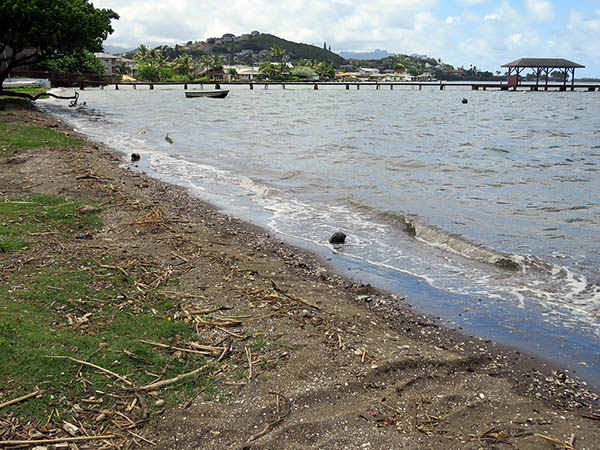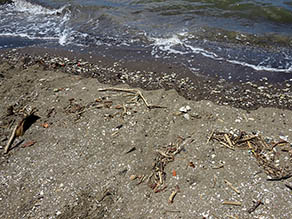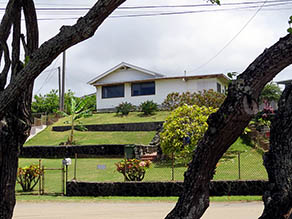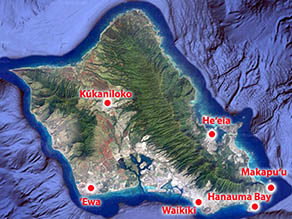 |
 |
 |
 |
||||||
|
|
|
|
|
|
|
|
|
|
 |
|
 |
|||||||
 |
“The chronology is flexible here. It is in twenty-year segments, and that’s a rough estimate of how long these various rulers ruled. You see the name Māweke. Māweke is a big name, and is the ancestor came up from Tahiti. His may be the first major name of this period, between the 1100s and the 1300s of incoming, high-born Tahitian chiefs. There is a senior line and the junior line. The senior line ends kind of abruptly about 1520 or so, so there are no really major names on that lineage. Kumuhonua and Mō‘īkeha and Olopana are said to be three brothers. So from Māweke, we see the name Kea‘unui and this name survives today. Many descendants in the Ko‘olau area bear the name Kea‘unui. 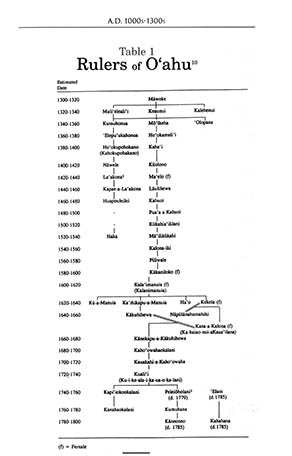
“And there's the major chief [ali‘i]. Mō‘īkeha comes up here, settles on Kaua‘i, takes two Hawaiian wives and has a number of important sons. He has a very important place in Kaua‘i history and O‘ahu history. “La‘amaikahiki, was, some say, a hānai [adopted] grandson or nephew of Mō‘īkeha. La‘a was a very high-born youth in northern Tahiti, on a point of land called Mahina. This is where later, on his first voyage, Captain Cook decided this was where they would erect an observatory to observe the transit of Venus. Consequently they named the place Point Venus. The Tahitians call that area Mahina. That’s where La‘a was from. “Now La‘a was left back in Tahiti when Mō‘īkeha migrated up here and visited—typically he visited all the islands—and then decided to settle on Kaua‘i. When he was getting along in years, Mō‘īkeha decided he wanted La‘a to come here to Hawai‘i and to take his bones, Mō‘īkeha’s bones, back to the family vault. He had three or four sons in Hawai‘i, and he tested their capabilities, then decided on Kila (the youngest) as the most reliable. “So he sent Kila back to Tahiti with the kahuna [priest, navigator]. And so Kila left for Tahiti departing through the channel between Lāna‘i and Kaho‘olawe which is called, of course, Ke Ala i Kahiki, the Pathway to Tahiti. And even that point of land on Kaho‘olawe is also named the same. But the Ka‘ū people say the last place he left from was near South Point of Kalae, and that would make sense. That’s the straightest way back to Tahiti. “Kila makes it to Mahina, he sets about trying to locate La‘a, and finally finds out that La‘a is in the interior living in seclusion. Kila is able to approach La‘a and to tell him about Mō‘īkeha‘s wish. So somewhat reluctantly, La‘a decides he’ll collaborate. And so he pulls together a whole retinue of people to migrate up here to Hawai‘i. It would be a big undertaking. 
“There are two or three important cultural contributions that La‘a brings here to Hawai‘i that have a big impact. One of them is the Kā‘eke‘eke, drum—he calls it at that time, Kā‘eke‘eke was a name for the temple drum. He brought two of them up here. Two, big, huge temple drums, and by the way they’re both in Bishop Museum. The name for the one I saw on display at the museum is called Hāwea. And it is huge, it’s pretty. So the story goes that as the double canoe was approaching O‘ahu, on board the canoe, they’re beating the drums. Well, Hawai‘i never had temple drums prior to that, so it’s an entirely new sound. “And one man on shore there at Hanauma Bay hears the drumming on board the canoe. And he follows the canoe. He’s very intrigued by the sound and he follows the canoe all the way around to Kāne‘ohe Bay. From Hanauma all that distance to Kāne‘ohe Bay, a long way to go. And he’s also memorizing the beats on his chest. So one of La‘a’s major cultural innovations to Hawai‘i was the temple drum, which came to be used, ultimately, in hula as well. “Another major contribution was bringing up the god Lonoikaouali‘i, fore-runner of Lonoikamakahiki, The godhead. So it enhanced Lono worship, because of the evolution of the godhead from Lonoikaouali‘i to Lonoikamakahiki. So La‘a is very important for that contribution to Hawaiian religion. “So the story goes, La‘a delivered some passengers who wanted to get off on the Big Island—Kumukahi and other such notables. La‘a arrived at Makapu‘u point on O‘ahu, and this is where some also wanted to disembark, and left there. Then La‘a sails into Kāne‘ohe bay falls, in love with the place, and decides that’s where he wants to build his compound at the beach today called Nāoneala‘a, ‘The sands created by La‘a.’ Because where La‘a landed and settled was muddy. The bay is silty. “So what does he do? To make it easier for landing and launching canoes, he had teams of his men import sand from a given area—a black-sand cinder cone from over on Mōkapu—and they brought the sand over, canoe load by canoe load. Now today if you go to that beach, and you dig down maybe five or six inches beneath all the modern detritus there, deep down below you come across grey or in some cases black sand. Otherwise it is just a muddy covering over everything down there. So the sand is actually still there after seven hundred years. That’s why the name NāoneaLa‘a, 'The sands created by La‘a.' “La‘a also had three heiau constructed: one on the hill behind the beach that he created, and then two other heiau he named for his sons. He had three sons. La‘a was ultra-high born, from Mahina, Tahiti. He took three O‘ahu wives. One wife was from Kāne‘ohe, one from Ka‘alaea, a small adjoining ahupua‘a this side of He‘eia. And the third wife was from Kualoa. So a remarkable thing happend: he got these three Hawaiian wives pregnant, and they all delivered. Three sons on the same day! Now, how often does that happen in history?! (Although they had to really urge the third one to make the deadline, but she did.) “These three sons became the highest born leaders, rulers of Kaua‘i and O‘ahu, which is where it all was back in those earlier days. Those islands were the primary ruling island chiefdoms. The first two ruled on the Kaua‘i—Ahukini-a-La‘a and Ku-kona-a-La‘a. They are in the genealogies. The third son was Lā‘uli-a-La‘a, who ruled O‘ahu and from him descend the highest-born chiefs of O‘ahu. “La‘amaikahiki brought a very important retinue to Hawai‘i, he brought at least two major late-Tahitian cultural innovations, and he had these three royal sons. So he’s a very big name. Emalia and I are direct descendents of La‘amaikahiki. You trace back to the thirteen hundreds! Well, I did the same thing, and lo and behold! I’m on that line too. So, it’s a discovery! “I believe Lā‘uli-a-La‘a ruled from Ko‘olaupoko. The power center was here, Kāne‘ohe and later Kailua, and also Kualoa. And then later you have the rise of the ‘Ewa chiefs around Pearl Harbor and they rise in power with Mā‘ilikūkahi. Then they create a capital up at Līhu‘e, the area mauka of Schofield Barracks, up toward Ka‘ala. The Līhu‘e capital complex has been destroyed because of the military happenings there. Then we find that Waikīkī becomes the royal resort and sometimes the capital too. So I would have to say these three areas are most important for where the capital was centered. Earliest on in Ko‘olaupoko, and then later ‘Ewa and then Waikīkī. “Mā‘ilikūkahi was an important ruler of O‘ahu and also the founder, they say, of Kūkaniloko as the royal birthing place. He kind of united O‘ahu. He ruled from ‘Ewa, he was one of the ‘Ewa Chiefs, and then established the capital in Waikīkī. Then we see the name Kalonaiki and there’s also Kalonanui and there is a connection with the important Pi‘ilani lineage of Maui. That’s where they link up. And then further down, you see the name Kūkaniloko, and that’s for a female. “So back to Kūkaniloko on down to 1640. You see the name Kakūhihewa. He was said to have been born at Kūkaniloko. Kakūhihewa ruled O‘ahu from Kailua, and had a major royal complex there. And then he relocated the capital to Waikīkī. So on down to the 1720s or so, there’s the name Kuali‘i. Kuali‘i was born at that location by the outlet of Ka‘elepulu, at the river outle called Kalapawai in today's Kailua. “Kuali‘i was a very important name, a high-born ruler who ruled from Kualoa. And the thing that intrigues some of us is that he is said to have voyaged to California! The land of fog. Might have been Mexico, but a distant land, it was cold and foggy. This is pre-Captain Cook. “Kuali‘i had two sons. The no-good one was Kapi‘iohokalani. He led a disastrous invasion of Moloka‘i and was defeated in battle there. But the good son of his is Peleioholani, who inherited the rule both of Kaua‘i and of O‘ahu. And again, these chiefs are focused here in the Ko‘olaupoko area. Kuali‘i in Kualoa and Peleioholani both here and on Kaua‘i. This is the time of the expansion of the Big Island chiefs, who were reaching out and repeatedly invading Maui. Alapa‘i Nui, the Big Island high chief, had wanted to invade to conquer and include O‘ahu in his little kingdom. Alapa‘inui’s fleet had come into the Kāne‘ohe bay and his fleet extended all the way from Mōkapu over to the fish pond area, Waikalua. He had that many canoes! 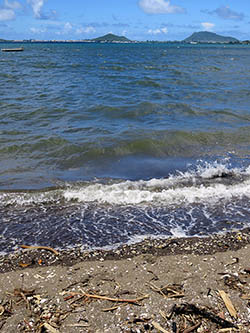
“Fortunately Peleioholani’s kahunas said, ‘Okay, we should try to establish a peace accord to prevent all the bloodshed that would inevitably happen.’ Peleioholani was instructed to leave his warriors up on the hill and come down by himself, alone. And Alapa‘inui was to come off his canoe, come ashore alone, and the two of them did embrace. They were brothers in law, by the way! (It’s always in the family.) "They embraced and they decided ‘Yes, let’s call it off. Let’s declare a peace accord.’ And so there was the famous peace accord of Nāoneala‘a. The year was around 1738, roughly, maybe a little later. So the rulership of O‘ahu remained and stayed under Peleioholani, through Kumuhana and Kāneoneo. “And then there’s a nephew whose name is Kahahana. Kahahana was adopted his uncle, by the Maui 'king' Kahekili, and went to live with him on Maui. Kahekili was very envious and had intended to conquer O‘ahu. First of all, he wanted to lay claim to Kualoa, because that is where so many sperm whales beach. And he was wanting whale ivory for the making of royal pendants, the high symbols of rank and rule. So he made that claim to Kahahana, and the nephew agreed. “Kahekili ultmately killed Kahahana and then invaded O‘ahu and slaughtered the O‘ahu ali‘i, which in a sense ended all the royal connections of Ko‘olau. And so then O‘ahu became dependency of Maui through Kahekili. And on down. And then of course in 1795 Kamehameha invaded. And so the rulers of O‘ahu were wiped out.” Read more about this on the Nu‘uanu website.
|
 |
|
 |
But then came the Explorers, whose presence quickly changed everything on O‘ahu.
|
 |
||
 |
|
 |
||

|
 |
||||
|
||||
Copyright 2019 Pacific Worlds & Associates • Usage Policy • Webmaster |
||||
